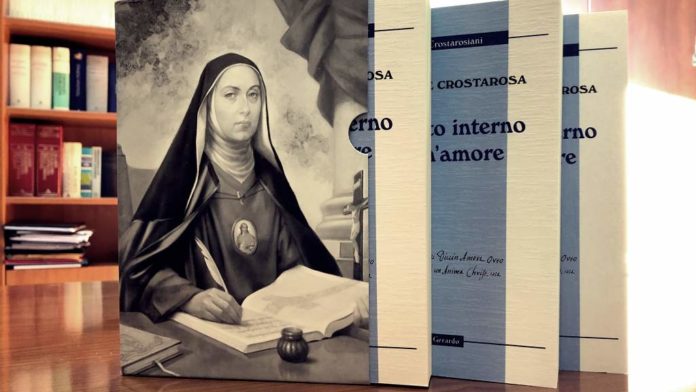At the beginning of November 2020, Fr. Sabatino Majorano gave it to the press, at the Editrice San Gerardo della Valsele typography of Materdomini(AV), the great work of blessed Maria Celeste Crostarosa Giardinetto interno del divino amore (An Interior Garden of Divine Love).
We are faced with the writing of more than 1000 pages. The work, included in its own title in the series “Testi e Studi Crostarosiani” (vol. 11-13), presenting itself impressive for a decent number of pages, has been divided into three volumes collected in a small box.
The original text was written by Crostarosa in the Foggia years around 1750, as Beata herself attests in her Autobiography.
The manuscript text of the Crostarosa is composed of two volumes of 600 pages. The first volume, of 518 pages, measuring 26×18 cm, is written by Sister Celeste. The second volume, of about 80 pages, measuring 27.5×19 cm, is written by another handwriting contemporary to the Blessed one. Accordingly to fr. Majorano, it is probable that this second part has been completed “when Maria Celeste Crostarosa must have felt too heavy to write or immediately after her death on drafts and notes written by her” (vol. I, p. 6). This edition is opened by an extensive methodological introduction where the editor presents the articulation and references of the work as well as the scientific criteria adopted.
Before going on to the content of the work, it should be pointed out that Sister Maria Celeste Crostarosa commented on the Holy Gospel with four writings, a theme that is also dealt with in this text. The writings – already published in this series edited by S. Majorano – are: Esercizio di amore di Dio per tutti i giorni dell’anno; Esercizio d’amore per la quaresima; Meditazione unite ai Santi Evangelii; and finally Giardinetto interno del divino amore.
Exercise of God’s love for all days of the year; Exercise of love for Lent; Meditation united to the Evangelical Saints; and finally, Interior Garden of Divine Love.
With the Giardinetto, the Blessed one aims to comment on the stories of Jesus’ childhood and the beginning of his public life according to the Gospels of Matthew and Luke. She then moves on to comment on chapters 1-12 of the Gospel of John, which occupy most of the pages. The comments are opened by the Latin quotations of the evangelical pericope following the order of the chapters and verses of the gospels examined. It should be noted that the text of the Bible used by Sister Mary Heavenly was the Vulgate, that is, the official tense in Latin. Historically, the first edition of the Bible in Italian, allowed by the ecclesiastical authorities, was the edition edited by Antonio Martini between 1769 and 1781, then after the Crostarosa. In fact, previously it was forbidden according to the indications of the Tridentine Council (1545-1563) to divulge the Bible in the current language.
Going to the content of the work, we can say that the Gardinetto Spirituale collects not only simple meditations but spiritual elevations on very dense themes spiritually. In fact, the text is rich and articulated. The spiritual elevations that the Blessed proposes are very broad and written in the mystical language.
The main content of the work is the narration of the “admirable humiliations of the Word” and how these are the main path of the spiritual life. In fact, in the Gardinetto the Blessed describes the phases of the spiritual journey of the soul, from the call to divine intimacy to union with God, passing through inner purification and the gift of contemplation. The spiritual elevations do not narrate historical facts but are movements and states of the soul that narrate its inner journey under the breath of the Spirit. They are characterized by a contemplative concentration on truths or concrete aspects of the life of the Lord, and the Virgin felt as a deep inner life. We are faced with very dense pages on a spiritual level. For example, he writes in the elevation of April 5 that before the light of the Spirit “The mental verb” reveals itself to be “all impure and material” (vol. II, p. 107).
If this is essentially an aspect of the content of the work we are presenting, we must give credit to Fr. Majorano – one of the deepest connoisseurs of the spirituality and dynamics of the living memory of the Crustarosa – who, with this publication, has completed the arduous project of publishing the works of the Blessed one begun in the mid-nineties of the last century.
It is obligatory to congratulate Fr. Majorano for the publication of this volume in three volumes and for the additional piece he places for the knowledge of the spirituality of the Crustarosa.
Finally, I think it is due to thank the province of Naples that has taken charge economically of the publication of the whole series “Testi e Studi Crostarosiani”. The series, as it was written previously directed by Sabatino Majorano, has been published by Valsele Tipografica that has taken care of the graphic aspect, giving a touch of elegance to all the volumes. For more information about the works of the Crostarosa, you can contact the secretariat of the typography at the following address valsele@netlab.it.
Alfonso V. Amarante, C.Ss.R.







